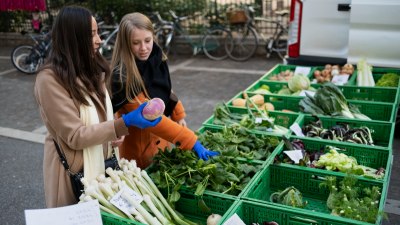Why Food Markets Look Completely Different Depending on the Season
Discover how seasonal changes affect food markets and which products thrive in different times of the year.

Food markets are vibrant spaces that reflect the seasonality of produce, influencing their appearance, variety, and appeal.
As the seasons change, so do the offerings in food markets. This transformation is primarily dictated by agricultural cycles, climatic conditions, and consumer demand. Understanding these seasonal shifts not only enriches consumers' shopping experiences but also supports local agriculture and sustainability.
The Role of Seasonality in Agriculture
Seasonality plays a fundamental role in agriculture, determining what crops can be planted, grown, and harvested at any given time. Farmers plan their planting schedules based on the climate, soil conditions, and historical weather patterns. For example, crops like strawberries and tomatoes thrive during the warm months of summer, while root vegetables like carrots and potatoes flourish in cooler temperatures.
The impact of these seasonal variations is visually evident in food markets. In summer, vibrant colors of fresh berries, leafy greens, and bright tomatoes dominate the stalls, while in winter, consumers may find an abundance of root vegetables, hearty greens, and stored produce like squash and apples.
Consumer preferences also shift with the seasons, influenced by cultural traditions, holidays, and personal choices. For instance, autumn brings cravings for hearty soups and pies made from seasonal ingredients like pumpkins and apples. During the summer, there is a surge in demand for fresh salads, fruits, and barbecued meat, leading to a diverse array at local food markets.
Moreover, individuals are becoming increasingly aware of the benefits of eating seasonally. Seasonal eating promotes a diet rich in variety and freshness, as seasonal produce is often at its peak in taste and nutritional value. Food markets adjust to meet these changing consumer demands, providing products that align with seasonal preferences.
The Influence of Weather and Climate
Weather plays a critical role in determining the availability and quality of food products throughout the year. Unpredictable weather patterns, such as unseasonably warm winters or excessively rainy summers, can affect crop yields and, consequently, market offerings. For instance, a late frost may damage flowering fruit trees, resulting in lower quantities of apples and pears in the fall.
In turn, these weather phenomena create variability in pricing and availability. When a certain produce is in short supply due to adverse weather, prices may increase, prompting markets to source alternatives or imported products to meet consumer needs. As a result, food market landscapes can shift dramatically from one season to the next depending on climate conditions and their effects on agriculture.
Regional Differences in Seasonal Markets
Geographical location significantly affects the seasonality of food markets. Areas with distinct four-season climates, such as the northeastern United States, experience stark differences in market offerings throughout the year. In contrast, regions with milder climates, such as California, can produce a more stable selection of fruits and vegetables year-round.
Farmers' markets in warmer regions often showcase a greater variety of fresh products for extended periods. During winter months, consumers in colder climates may rely on preserved items, such as canned or frozen goods, while suburban farmers' markets in warmer areas can still offer fresh greens, citrus, and early spring produce like asparagus.
The Impact of Local Sourcing
More consumers are becoming interested in locally sourced food, which is closely tied to seasonal availability. Buying from local farms and markets fosters a connection between producers and consumers, ensuring that customers receive the freshest, most flavorful products. In many cases, local farms can provide a wider variety of goods than their larger counterparts, directly reflecting the season's changes.
By supporting local producers, consumers also contribute to sustainable agricultural practices. Farmers often adopt methods such as crop rotation, regenerative practices, and organic farming, which yield healthy food while minimizing environmental impact. This commitment to local sourcing not only directly affects food markets but also fosters a sense of community and cooperation within the agricultural sector.
Food Preservation: A Seasonal Necessity
As the growing seasons come to an end, the preservation of seasonal bounty becomes vital for food markets. Techniques such as canning, pickling, and fermenting allow consumers to enjoy seasonal goods year-round. In many food markets, you will find stalls dedicated to preserved goods made from summer harvests, such as jams, jellies, pickles, and dried fruits.
Preserving seasonal foods not only extends their shelf life but also showcases culinary creativity. For instance, fermented vegetables like sauerkraut and kimchi provide nutritious options for winter months and offer valuable probiotics to support gut health. Making these products available in food markets allows consumers to experience a taste of summer all year long.
The Aesthetic Appeal of Seasonal Markets
The visual transformation of food markets across the seasons adds to their allure and draws in consumers. The warm hues of fall foliage and the scents of spiced apple cider create a cozy atmosphere in autumn, while the bright greens and floral aromas of spring evoke feelings of rejuvenation. Producers often design market displays based on seasonal aesthetics, tempting shoppers to embrace the season through food.
This seasonal aesthetic also influences food-related events and festivals. Many markets organize seasonal celebrations, offering tastings, cooking demonstrations, and crafts. For example, farmers' markets in the summer may host fresh berry festivals, while autumn brings pumpkin festivals, showcasing the diverse and dynamic character of seasonal produce.
Food markets are fascinating spaces that illustrate the relationship between seasonality and consumer habits. With crops dictated by the weather, regional differences, and local sourcing practices, the transformation of food markets across seasons reflects a rich tapestry of flavors, colors, and sensory experiences. By understanding these changes, consumers can appreciate the beauty of seasonal produce while making choices that support their local economy and sustainable practices.
As you explore food markets throughout the year, consider the story behind the food on display—where it was grown, how it was produced, and the seasonality that brought it into your shopping basket. Embrace the seasonal journey of food markets, and let the changing seasons enhance your culinary experiences.











